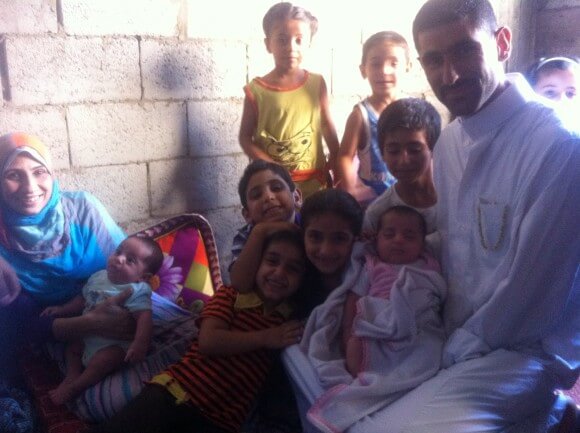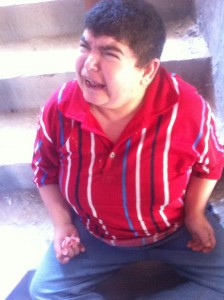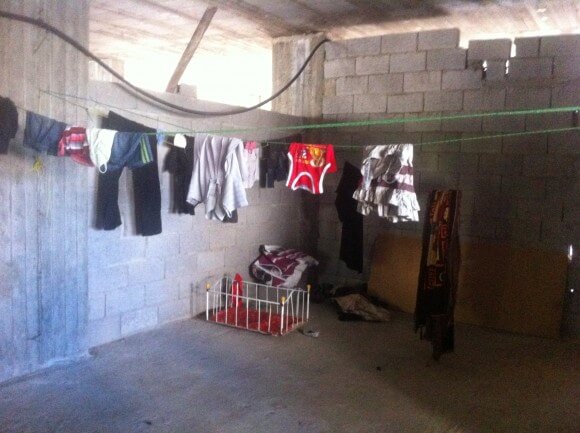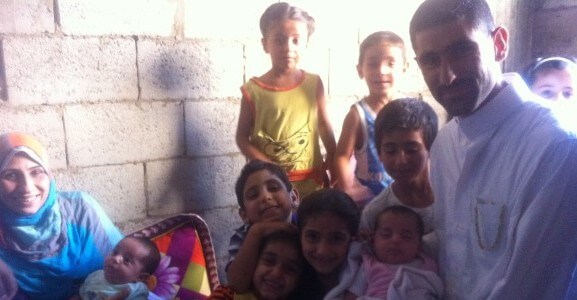
In Gaza City thousands of Palestinians have taken shelter outside of United Nations facilities out of fear of air-strikes targeting the civilian sanctuaries. They live in rented rooms, in the backs of stores, in half-erected building and on the streets. If they interact with local or international non-governmental organization, they are counted in the log of displaced persons. Yet many from the northern regions which are now a flattened abyss of exploded homes are not recorded. They inhabit the fringes of Gaza City.
The el-Algan family has joined over 550,000 displaced Palestinians across the besieged Gaza Strip. They fled nearly two weeks ago from their home in Zeitoun near Shuja’iyeh, a northern town that today is a desolate, post-apocalyptic wasteland of bombed out buildings where bodies are still trapped under rubble. “I built it new eight years ago,” said Hussein Mohammed Ali el-Algan, 50, of his former home.
“When the tanks started shooting, that was it. We realized we couldn’t live there anymore,” said el-Algan while seated on a plastic chair next to the sidewalk. “When we left, we left all of us together,” with each adult carrying one of the smaller children. Even his 15-year old daughter carted a youngster as they walked aimlessly toward the sea, looking for a hideout from the shelling. “It was very hard there and we have to live and we have to survive.”
The el-Algan’s have insulated themselves inside of a three-story concrete frame of an incomplete building with another family, the Zenad’s. Together they hope to ride out Israel’s Operation Protective Edge, now in it’s 28th day. Their entire living space is a mere 250 square meters.

The ten members of the Zenad family who also reside in the construction site include three mentally disabled adults. Shireen Zenad, 33, crouched on cinder blocks stacked into makeshift stairs. She tearfully howled, still traumatized from the evening before. El-Algan explained that the night before, she and Ashraf Zenad, 37, and Asra Zenad, 18, fled into the Gaza City’s dark streets illuminated by artillery smashing into nearby buildings. The other family members chased after them, an unfortunate daily pattern of braving Israeli F-16s and drone strikes in order to retrieve their loved ones from danger.
“The Israelis, they tried to make a road for their tanks so they demolished their house,” said el-Algan of the Zenad home. His days are now filled with waiting out artillery fire and rushing to a local store to fill a one-gallon yellow water tank during the respites of ceasefires. Through a generator hooked up to a neighbor’s house el-Algan has outfitted his shelter with four hours of electricity per day. He uses it to play a radio, which has become his primary source of news. When I spoke to them on July 25th, they had not eaten or drank for days. While the Zenad’s know that their home in Shuja’iyeh was destroyed by Israeli fire, the el-Algan’s have not been able to travel back to their town to check on their belongings. The trip is dangerous and long, about an hour and a half by foot.

Gaza City is serving as an effective refugee camp for those fleeing the more war-torn regions to the north and east. Like many displaced Palestinians the el-Algan family decided not to relocate to a United Nations shelter. The UNRWA operates over 100 shelters with more than 80 people living in each classroom of the converted schools. Disease has started to spread—skin rashes and scabies—and so el-Algan prefers his construction site. While there are no real walls, cinder blocks and fabric drapes the openings. There is a semblance of “the most simple things like privacy and privacy during bathing,” said el-Algan’s brother-in-law, Ahmad el-Algan, 38. Still, residing outside of a designated shelter comes with uncertainty. “Even here there’s no security,” said Ahmad el-Algan explaining the night before the building behind their shelter was struck with missiles. The explosion damaged part of the structure they use as sleeping quarters.
Situated a short walk from the el-Algan’s shelter is a lush green square, a park honoring Gaza’s unknown fallen soldiers. Outside of wartime, the garden is a playground with children rushing monkey bars. But since Israel’s ground invasion began nearly four weeks ago the park has doubled as a shantytown for refugees who could not find space in shelters, afford to rent a flat elsewhere, or have family to host them. In a corner shaded by trees Rada Zaheles, 40, sits on a dirt square with her 13 children, her sisters and her sister’s children. Together there are 30 children. Her youngest is three years old. Beside Zaheles, her sister Naima Zaheles holds her nine-month old daughter.
“I prefer to die next to my house than to live here like this,” said Zaheles reaching her hands out as she spoke. “There’s no money, nothing. When people leave from the schools and the hospitals they bring us food.”
The Zaheles family, also from Shuja’iyeh split apart two weeks ago. It has become common in Gaza for families to separate under the logic that if an air strikes falls on them, the whole family will not be wiped out because others are taking shelter elsewhere. “Some are in Shifa hospital, some are in the school and we are in the park,” said Zaheles, continuing. “Why did this happen to us, we were in our house and now all we want is some privacy.”
If the el-Algan’s days in the construction site are bleak, the Zaheles’s are hellish. Gaza’s climate is warm, much warmer than Jerusalem in the summer, and sitting outdoors for long hours without food or water, starvation was a concern. The family of women had no spare clothing for the children, not even a pad to sleep on. “All I want to do is to start screaming and crying so that people will come and stand beside me,” wept Zaheles.



You are doing a great job Allison!
Only way to stop this is ICC where the puppet Abbas refuse to become a member of.
Bearing witness with compassion and profound understanding, as always.
You profile 3 families of the 1/2 million that are displaced… it helps toward understanding the enormity of the awful situation that Israel created for the people of Gaza. This is mind- boggling and deliberately inflicted trauma that will never be erased, yet in your first photo there are smiles……not in the least due to the fact that you care.
(it appears to me that traumatized Shireen suffers from physical disability as well)
.
it takes very strong parents to keep up the
spirits of their families while facing such
grave conditions noone should have to go
through so much let alone two million
.
guns don’t kill people people kill people
shame to Israel such shame will be yours forevermore
.
G-d Bless
That is a lot of sad and traumatized human beings. The arrogance of Israel, and the brutal method of punishing civilians, has resulted in a humanitarian crisis, which will become a big problem for the rest of the world. Their homes have been decimated, and they are totally helpless. There is no point looking for help from their fellow Arabs, they have not uttered a word throughout this slaughter and bombardment, by their new BFF Israel. They are the most selfish lot. I guess they must have been to afraid of the US and it’s side kick Israel to even condemn this attack on Gaza.
I feel so bad for all these people, especially the children. Their suffering will never really be over.
It’s odd how we the onlookers and those outside of Gaza & Palestine watch from afar, a slow genocide that happens when Israel is in need of a military victory. And if you call killing civilians a victory, then Israel is the victor and will continue to do so, until they are brought before the ICC. Are we going to see pictures of Hamas central command station under the hospitals? -not as if it’s any excuse for collateral damage on a civilian prison camp.
*Chomsky on Twitter. This is all he had to say about Israel/Gaza on his twitter feed the last 3 weeks: “(Israel’s crimes) will continue as long as it is supported by Washington and tolerated by Europe – to our everlasting shame.” ~Usually Chomsky is good at singling out dictators like Suharto, Saddam,etc. I wonder why he doesn’t touch Netanyahu? – who seems increasingly fascist with a stocked cabinet who supports his six decade colonial enterprise.